
Publisher:
Bonnie King
CONTACT:
Newsroom@Salem-news.com
Advertising:
Adsales@Salem-news.com

~Truth~
~Justice~
~Peace~
TJP
Oct-17-2011 04:14

 TweetFollow @OregonNews
TweetFollow @OregonNews
Da Nang International Airport - Agent Orange and the Removal of Dioxin: Status
Chuck Palazzo Salem-News.comBetween 1962 and 1971, the United States military sprayed 20,000,000 US gallons (80,000,000 L) of chemical herbicides and defoliants on SE Asia.
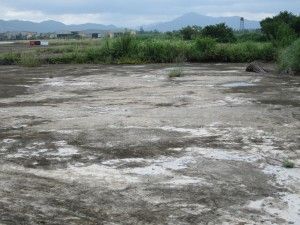 Source: Agent Orange Action Group |
(DA NANG, Vietnam) - Da Nang International Airport is the 3rd largest airport in Vietnam. Over 1 million passengers travel through the airport annually. This number is expected to rise to over 4 million passengers by 2020. In anticipation of this growth, there is a major project underway to expand the runways as well as the construction of a new international terminal. After the project is complete, the airport will have a total capacity of 6 million passengers per year.
During the Vietnam War, the facility was known as Da Nang Air Base. This was a major United States military base. Da Nang became the world’s busiest airport in the single runway category. In the mid-1960’s, 1,500 landings and takeoffs were recorded on peak days. When a second runway was added in 1966, Da Nang rivaled Tan Son Nhut as the world’s busiest airport. By 1968 an average month saw the number of takeoffs and landings of fixed-wing aircraft exceeding 55,000. With helicopter activities added, this figure approached 67,000.
Agent Orange
Agent Orange is the code name for one of the herbicides and defoliants used by the U.S. military as part of its herbicidal warfare program, Operation Ranch Hand, during the Vietnam War from 1961 to 1971.
A 50:50 mixture of 2,4,5-T and 2,4-D, it was manufactured for the U.S. Department of Defense primarily by Monsanto Corporation and Dow Chemical. The herbicides used to produce Agent Orange were later discovered to be contaminated with 2,3,7,8-Tetrachlorodibenzodioxin (TCDD), an extremely toxic dioxin. Because of the large military demand for Agent Orange, the manufacturing processes were accelerated, resulting in higher levels of dioxin contamination than in the 2,4,5-T produced for civilian applications. It was given its name from the color of the orange-striped 55 US gallon (200 L) barrels in which it was shipped, and was by far the most widely used of the so-called “Rainbow Herbicides”.
Between 1962 and 1971, the United States military sprayed 20,000,000 US gallons (80,000,000 L) of chemical herbicides and defoliants in Vietnam, eastern Laos and parts of Cambodia, as part of Operation Ranch Hand. The program’s goal was to defoliate forested and rural land, depriving the Viet Cong and North Vietnamese Army of cover; another goal was to induce forced draft urbanization, destroying the ability of peasants to support themselves in the countryside, and forcing them to flee to the U.S. dominated cities, thus depriving the north of their rural support base and food supply.
.
U.S. Air Force planes flying a low altitude Agent Orange spraying mission
For ten years the US Air Force flew nearly 20,000 herbicide spray missions in order to destroy the forest cover as well as agricultural lands in key areas of southern Vietnam. By 1971, 12 percent of the total area of South Vietnam had been sprayed with defoliating chemicals, which were often applied at rates that were 13 times as high as the legal USDA limit. In South Vietnam alone, an estimated 10 million hectares of agricultural land were ultimately destroyed. In some areas TCDD concentrations in soil and water were hundreds of times greater than the levels considered “safe” by the U.S. Environmental Protection Agency. Overall, more than 20% of South Vietnam’s forests were sprayed at least once over a nine year period.
After being sprayed by Agent Orange – Environmental Impact
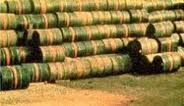 Barrels of Agent Orange, |
28 of the former US military bases in Vietnam where the herbicides were stored and loaded onto airplanes still have high levels of dioxins in the soil, posing a health threat to the surrounding communities. Extensive testing for dioxin contamination has been conducted at the former US airbases in Da Nang, Phu Cat and Bien Hoa. Much of the soil and sediment on the bases have extremely high levels of dioxin requiring remediation. The Da Nang Airbase has dioxin contamination up to 350 times higher than international recommendations for action. The contaminated soil and sediment continue to affect the citizens of Vietnam, poisoning their food chain and causing illnesses, serious skin diseases and a variety of cancers in the lungs, larynx, and prostate.
Of approximately 5 million Vietnamese who were exposed to Agent Orange/dioxin, 3 million people are estimated to be suffering from illnesses or birth defects. Hundreds of thousands have died as a result and many more continue to suffer.
In addition to those who were exposed to the spraying of Agent Orange, their children and grandchildren suffer horrific birth defects and disease as the genetic consequence of this poisoning enters the fourth generation. There is no end in sight.
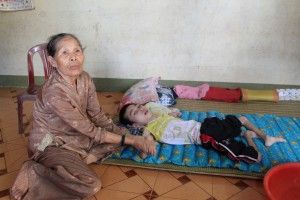 An Agent Orange victim in modern Vietnam. |
Today, 50 years after the first spraying of Agent Orange in Vietnam, the manufacturers of this poison, specifically Monsanto and Dow Chemical, have not provided any compensation or other means of assistance to the Vietnamese victims of Agent Orange. The US Government has done scant little more. The amounts of funding they have provided thus far, is miniscule compared to what is required.
Neither the manufacturers nor the US Government admits to any guilt for causing this catastrophe. The fourth generation of victims is being born with gross physical and mental defects, numerous diseases, and lifelong disabilities. The manufacturers continue to reap incredibly large profits.
The US Government is consistently careful not to admit responsibility for this chemical poisoning of the Vietnamese people or to the environment of Vietnam. A cable recently uncovered by WikiLeaks and dated August 10th, 2000 shows just how the US was determined NOT to offer direct assistance to Vietnam for the clean-up of Da Nang or elsewhere:
http://wikileaks.org/cable/2000/08/00HANOI1712.html
The Clean-up Commences
 At first glance, I thought this was a tombstone. |
On June 17th, 2011, Vietnam’s Ministry of National Defense officially began activities to detect and remove unexploded ordnance (UXO) to prepare for U.S. supported remediation of dioxin contamination at Da Nang Airport. Yes, detect and remove UXO that had been left, apparently undetected, since the war. After years of studies, finally, something is being done at what might very well be one of the worst dioxin contaminated sites in the entire world.
After much fanfare, nothing else appeared in the local or international press. No status. No results. What was the timeline? What method was being used for the remediation? What was the cost?
On August 13th, 2011, upon my return to Da Nang from the 2nd International Agent Orange/Dioxin Conference held in Hanoi, I was intent to find out the status of the clean-up at the Airport. I attempted to enter the area where so many barrels of Agent Orange had been stored during the war, so much spillage of Agent Orange occurring, so many aircraft being washed of the deadly poison – all entering the soil and water, contaminating the many heavily populated areas around the airport perimeter and beyond, causing death and destruction for so many decades.
I was turned away by both military and civilian security, and rightfully so. This area contains dioxin levels several hundred times the acceptable EPA figures. If Da Nang Airport was in the US, this most certainly would qualify as a Superfund site! http://www.epa.gov/superfund/about.htm<
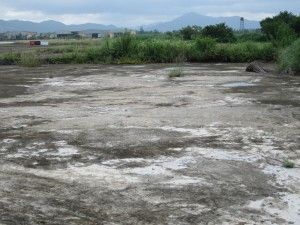 Site of dioxin contamination at Da Nang Airport |
I requested assistance from my colleagues at VAVA (Vietnam Association of Victims of Agent Orange/Dioxin) in Hanoi and Da Nang who immediately offered their help. They arranged for a site visit at the dioxin hot-spot for me and on September, 27th, 2011, I was granted access.
My first impressions of the site were grim. The stench of dioxin nauseating. The area that I now walked on had been cemented over a number of years earlier as an attempt to prevent further contamination from dioxin. This was the very site where Agent Orange had been stored, mixed, and loaded onto aircraft. It is a wetland area with shallow groundwater.
It is adjacent to a very densely populated residential area. This is the source of so much death, destruction and heartache.
I saw exactly what I expected and was afraid of. Zero activity. I looked around and saw no one. I asked the Vietnamese Military Officers who were escorting me on this visit, and they acknowledged there were no workers there, and had no idea why or when any work would continue (or begin?).
They recommended that I speak with the government environmental agency that is charged with overseeing the clean-up project. I had an appointment arranged for that Friday.
Environmental Department
On Friday, September 30th, I met with a representative from the Ministry of Defense, Department of Science, Technology and Environment. The gentleman I met with is a scientist as well as a high ranking military officer. He has been very heavily involved with the Agent Orange problem as well as the dioxin remediation at the three primary “hot-spots” in Vietnam (in addition to Da Nang, the other two are Phu Cat and Bien Hoa). After a few minutes of conversation, two things struck me immediately – this man impressed me with his scientific as well as practical knowledge of past studies, the current situation and the commencement of remediation, as well as, he cared very deeply about the people and the environment that have been so negatively impacted by the horrors of Agent Orange and dioxin for the past 50 years.
His explanation to me about the current status of the project and future plans was certainly scientific but he also emphasized the humanitarian aspects of the problem. More has to be done for the victims.
The completion date for dioxin clean-up at Da Nang Airport is 2016. This is the date that the American contractor who is doing the actual remediation plus USAID has committed to (the American contractor is CDM: http://cdm.com/en-AP.aspx and USAID is managing the budget including the disbursement of funds). The Vietnamese Government has mandated a completion date of 2015.
The official went on to explain the dioxin levels in and around Da Nang airport as well as the status of the clean-up effort. Right after the announcement had been made that the project would begin; the first task was that of UXO removal. I was surprised to hear that after so many years of being such an important and busy commercial airport, that there still remained UXO in the soil and surrounding marshes. The UXO removal had been completed within the past 30 days and resulted in “several hundred kilograms” of unexploded ordnance. This consisted of mortar rounds, artillery warheads, grenades, shrapnel bombs and various small arms ammunition. An official report presented by the Ministry of Defense confirmed these numbers and also states that “05 tons of scrap iron and other explosives” were removed as well.
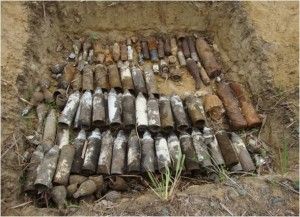 UXO found and removed at Da Nang Intl. |
The method of remediation that has been selected is known as In-Pile Thermal Desorption (IPTD). There is approximately 67,000 cubic meters of dioxin contaminated soil at the airport which will be processed by this method.
In effect, the contaminated soil will be excavated, hauled and placed in the IPTD pile structure. It is important to note, that this entire process will take place on premise at the airport. The pile structure itself will be constructed in close proximity of the contaminated area. This thermal technology, amongst other things, heats the soil to extreme highs (700-800 degrees centigrade) necessary to remove the dioxin contaminates.
In theory, the soil, once treated by IPTD will be returned to its “normal, pre-contaminated” state. I say “in theory”, because one question I asked the Doctor was if this method had ever been successfully used in removing dioxin at these very high levels. To his knowledge, it never has been – but he believes the technology will in fact work.
The structure itself will be approximately 70 meters wide by 105 meters long with a height of 6 meters of soil/sediment and 7.5 to 8 meters with bottom and top insulation systems.
The size of the project, amount of soil that will go through the process and energy needed to heat the soil to the extreme highs necessary requires a new and dedicated electrical plant. The construction of the plant is part of the project and will reside adjacent to the IPTD.
Timeline & Cost
During a recent presentation given by USAID at the Joint Advisory Committee held in Hanoi on September 22, 2011, the following timeline was established:
• September 2011: MND completes UXO clearance
• Late 2011/Early 2012: Receive GVN approval of EIA
• Spring 2012: Complete design of thermal treatment system
• Summer 2012: Begin excavation and construction
• Summer 2013: Begin thermal treatment system installation
• Summer 2016: Complete thermal treatment
• Late 2016: Site restored and project demobilized
Determining the cost of the project varies – some sources indicate a total of $34million to be dedicated to the remediation efforts in Da Nang. This is an initial cost estimate.
Next Steps
I want to mention and emphasize a few items. First, the manufacturers of Agent Orange, specifically Monsanto and Dow Chemical have never contributed any money for the Vietnamese victims of Agent Orange. There were other companies who produced this poison, but Monsanto produced the most volume and manufactured a much more potent version of Agent Orange – many times over and above what was required as an herbicide. They continue to deny their role in this disaster. To this day, their website reads:
“We believe that the adverse consequences alleged to have arisen out of the Vietnam War, including the use of Agent Orange, should be resolved by the governments that were involved”.
There are numerous studies which indicate the dangers of Agent Orange – proven to be responsible for disease, birth defects, mental illness, and death. US veterans who were exposed to Agent Orange during the war continue their struggle for recognition and compensation from the US Government. The Vietnamese victims have received nothing – nothing from the manufacturers and a pittance from the US Government. True, this project is a much needed start of what we hope will be remediation of all contaminated soil in Vietnam, but it is the victims who suffer the most – we are now entering a fourth generation of victims who are affected by the ravages of Agent Orange. Monsanto continues its denial and, has had the audacity to open offices in Ho Chi Minh City, Vietnam recently. Their purpose? Selling genetically modified seeds and organisms to the people of Vietnam. Monsanto is the largest producer of genetically engineered seeds in the world, a multi-billion dollar business which preys and thrives on selling broken promises, false hopes – and out and out lies, so they can improve their bottom line. Monsanto insists that GMO is harmless – just as they told us Agent Orange was and is harmless.
At the conclusion of our meeting, I asked the Doctor what if anything can I do to help him and to help the project. His response? Invite Monsanto to visit Da Nang. Show Monsanto what Agent Orange, their Agent Orange, has done to the people here. They must see for themselves the devastation that was caused by them.
Yes, this is a step in the right direction, but what about the rest of Vietnam? What about the other hot-spots? I was told that Phu Cat has a lesser problem andt there is a plan in place for remediation there. He could not give me a date, but I was told it would be soon. Phu Cat appears to be less complicated than Da Nang. What about Bien Hoa? He told me repeatedly during our meeting that Bien Hoa was “very complicated”. The studies and planning continue at Bien Hoa – and the problems with contamination and people affected could indeed be as bad as Da Nang. Bien Hoa was the site of several major spills of Agent Orange in early 1970. One was a spill of 7,500 gallons. Later that year three other spills occurred.
An Open Invitation to the Manufacturers of Agent Orange
Monsanto, from your office in Ho Chi Minh City, it’s a short taxi ride to the airport. A one hour flight will bring you to Da Nang. You don’t even have to leave the airport to see the site where remediation is soon to begin. But then again, you do need to see the destruction of human life. The birth defects. The physical and mental impairments. The disease. Perhaps if you took the time to see the generations of victims, the broken hearts, the misery, you would indeed set aside your corporate greed and lend a humanitarian hand to the victims. It has been 50 years since the US first sprayed your manufactured poison. This is an open invitation to the management of Monsanto – please come to Da Nang. See this, one of the several hot-spots in Vietnam. See the results of Agent Orange.
References:
Da Nang Association of Victims of Agent Orange/Dioxin
Embassy of the US, Hanoi
Hatfield Consultants, LTD
USAID
Vietnam Association of Victims of Agent Orange/Dioxin
Vietnam Ministry of Defense
Vietnam Red Cross
WikiLeaks Wikipedia
 Chuck Palazzo is a Marine Corps Vietnam Veteran, the Interim Editor for Agent Orange, and a longtime Vietnam Veterans Against the War Member. Chuck Palazzo has spent years since the war studying the impacts and effects of Agent Orange, a defoliant chemical sprayed by the U.S. govt. on the jungles of Vietnam. He says Dioxins have been re-discovered to cause all sorts of damage to humans. These include Heart Disease, Parkinsonism, Diabetes et cetera. Dioxins are already known to produce serious birth defects and a variety of cancers. The chemical is still sold in Third World Countries and is causing the same problems.
Chuck Palazzo is a Marine Corps Vietnam Veteran, the Interim Editor for Agent Orange, and a longtime Vietnam Veterans Against the War Member. Chuck Palazzo has spent years since the war studying the impacts and effects of Agent Orange, a defoliant chemical sprayed by the U.S. govt. on the jungles of Vietnam. He says Dioxins have been re-discovered to cause all sorts of damage to humans. These include Heart Disease, Parkinsonism, Diabetes et cetera. Dioxins are already known to produce serious birth defects and a variety of cancers. The chemical is still sold in Third World Countries and is causing the same problems.
We at Salem-News.com welcome Chuck aboard and look forward to sharing more of his stories with our readers in the future.
Articles for October 16, 2011 | Articles for October 17, 2011 | Articles for October 18, 2011

Quick Links
DINING
Willamette UniversityGoudy Commons Cafe
Dine on the Queen
Willamette Queen Sternwheeler
MUST SEE SALEM
Oregon Capitol ToursCapitol History Gateway
Willamette River Ride
Willamette Queen Sternwheeler
Historic Home Tours:
Deepwood Museum
The Bush House
Gaiety Hollow Garden
AUCTIONS - APPRAISALS
Auction Masters & AppraisalsCONSTRUCTION SERVICES
Roofing and ContractingSheridan, Ore.
ONLINE SHOPPING
Special Occasion DressesAdvertise with Salem-News
Contact:AdSales@Salem-News.com


Salem-News.com:

Terms of Service | Privacy Policy


All comments and messages are approved by people and self promotional links or unacceptable comments are denied.
Leowayne Heino July 19, 2022 6:20 pm (Pacific time)
Approximately 1974, I was living near Redding,Ca. There was an article about AO in the local Redding Record Searchlight stating that anyone exposed to or around AO, visit your VSO. SO, I called and got appt. With the VSO. I went in and he met me in the hallway. He asked, where we're you stationed, 1968 DaNang, 69 Udorn, 70 Ubon. What type of aircraft were used, I told him, C-124's. What did they call the planes, I said Ranchhands? He looked at me and said, your a damn liar, we never had those planes there. I turn and walked of, and have been mad and dealing with AO EVER SINCE.
Ralph Land October 21, 2011 9:09 am (Pacific time)
What happened to the 50 million dollars that was given to Hanoi and some more funds were promised by Hillary Clinton. What has happened to those money to be used for the clean-up. It looks to me that both governments are as usual telling the the whole truth. Then the soldiers and people are the one's that suffer.
Mark Shapiro October 17, 2011 1:49 pm (Pacific time)
Excellent article Chuck!
[Return to Top]©2025 Salem-News.com. All opinions expressed in this article are those of the author and do not necessarily reflect those of Salem-News.com.